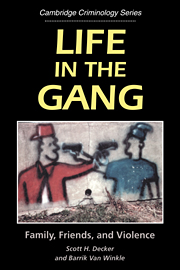Book contents
- Frontmatter
- Contents
- Acknowledgments
- Preface
- Chapter One Life in the Gang: Family, Friends, and Violence
- Chapter Two “Are You Claiming?” Methods of Study
- Chapter Three “I'm Down with the Bloods, What's up Cuz?” Membership Issues
- Chapter Four “We Ain't No Worldwide Thing or Nothing”: Gang Structure and Relationships
- Chapter Five “Where You Hanging? Let's Go Banging”: What Gang Members Do
- Chapter Six “I Love to Bang”: Serious Crime by Gang Members
- Chapter Seven “Doing Time” in School and Elsewhere: Gang Members and Social Institutions
- Chapter Eight “My Mom Doesn't Know”: Gang Members and Their Families
- Chapter Nine “There's Only Two Ways to Leave the Gang, Die or Move”: Responding to Gangs
- Notes
- References
- Index of Gang Members, Relatives, and Ex-Members
- Subject Index
Chapter Nine - “There's Only Two Ways to Leave the Gang, Die or Move”: Responding to Gangs
Published online by Cambridge University Press: 05 June 2012
- Frontmatter
- Contents
- Acknowledgments
- Preface
- Chapter One Life in the Gang: Family, Friends, and Violence
- Chapter Two “Are You Claiming?” Methods of Study
- Chapter Three “I'm Down with the Bloods, What's up Cuz?” Membership Issues
- Chapter Four “We Ain't No Worldwide Thing or Nothing”: Gang Structure and Relationships
- Chapter Five “Where You Hanging? Let's Go Banging”: What Gang Members Do
- Chapter Six “I Love to Bang”: Serious Crime by Gang Members
- Chapter Seven “Doing Time” in School and Elsewhere: Gang Members and Social Institutions
- Chapter Eight “My Mom Doesn't Know”: Gang Members and Their Families
- Chapter Nine “There's Only Two Ways to Leave the Gang, Die or Move”: Responding to Gangs
- Notes
- References
- Index of Gang Members, Relatives, and Ex-Members
- Subject Index
Summary
THIS BOOK HAS examined the group process and values of the gang within the context of social institutions. We have done this by focusing on the gang member's perspective, highlighting the insights of gang members regarding the nature of gang membership, the structure of the gang, gang activities, and relationships with social institutions. In this, the concluding chapter, we discuss strategies for responding to gangs. We begin by reviewing what gang members told us about how to stop people from joining gangs and how to eliminate their gang. Then we examine the responses of a number of ex-gang members to questions about leaving their gang. Following this, the salient cultural and institutional features of the gang are highlighted for their role in responding to gangs. Next we discuss a number of gang intervention strategies in light of our findings. We conclude by considering the role of social capital in gang formation and membership.
In order to respond to gangs, both their proximate and fundamental causes must be addressed. Examining both levels can only be accomplished through purposive institutional and community actions that ultimately have an effect on the values that are the underpinning of the gang. The proximate, or immediate, causes of gangs include the threats gangs generate, their values that reinforce violence, and the lack of legitimate activities in the neighborhoods where most gang members live. The fundamental causes that must be addressed include racism, unemployment, the lack of jobs, and the demise of the family in urban America.
- Type
- Chapter
- Information
- Life in the GangFamily, Friends, and Violence, pp. 261 - 280Publisher: Cambridge University PressPrint publication year: 1996



